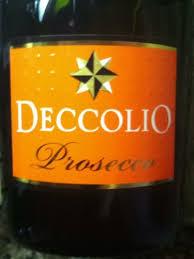Reviews of the Deccolio Prosecco and Jim Beam White Label Kentucky Straight Bourbon Whiskey.
By Joshua E. London and Lou Marmon
Washington Jewish Week June 18, 2015

There are tens of thousands of wineries across the planet, after all, including nearly 9000 in the US alone, with nearly half of those just in California. Apparently, though, the global thirst for wine is not so easily quenched. According to a recent Vinexpo and the IWSR drinks industry report, annual wine consumption will increase to 273 billion cases by 2018. As pointed out by Wine Spectator magazine, that is equivalent to 32.8 billion bottles or enough to flood Manhattan. That’s a lot of wine.
Producers seem all too eager to try and meet demand, however. So despite wine being a remarkably tough business to succeed in, the number of new wineries and wine brands being started and the sheer acreage of cultivable land being newly planted with wine grapes are steadily increasing the world over.
Of course, when we recall that wine, not in the abstract but in the particular, necessarily comes from this or that place in a fixed point in time, shortages seem less farfetched. Thus, late last month came news that the world may soon run out of Prosecco. As the USAToday reported, “a shortage of the Italian bubbly could occur as a result of high demand and rainy weather, according to Roberto Cremonese, the export manager of the popular prosecco manufacturer Bisol.”
Prosecco is a sparkling wine made in the Friuli, Venezia, Giulia, and Veneto regions of northeastern Italy. There are some lovely, jolly good, kosher Proseccos on the market. Consider, for example, the Deccolio Prosecco ($11; sold at Whole Foods Markets), which offers floral, green apple, and tangerine aromas that develop into honey, pear, and lemon flavors in a medium bodied, nicely effervescent frame with hints of mineral and spice in the finish.
In truth, this “shortage” may also just be a marketing wheeze to drive up prices—note the “could occur” turn of phrase. By contrast, The Drinks Business, a trade publication, days ago reported: “News of an upcoming Sauvignon Blanc shortage has been confirmed by New Zealand Winegrowers as the 2015 vintage is almost one third smaller than last year.” The quality of the 2015 vintage is expected to be great, due to a fabulous summer creating excellent conditions for ripening grapes, but the crop yields were diminished by 27 percent due to an unexpected spring frost.
So while Prosecco “may” experience a shortage, New Zealand Sauvignon Blanc will definitely suffer a shortage, so expect prices to increase. Fans should buy and drink now, while the price and weather is right. A great kosher New Zealand option is the classically composed Goose Bay Sauvignon Blanc 2013 ($20) that opens with citrusy floral aromas and hints of grass with peach, herbal, and melon flavors in a smooth frame nicely balanced with lemon and green apple.
Spirits-wise, all this talk of wine shortage brings to mind the much debated “bourbon shortage” whisky geeks keep going on about. The Whisky Advocate magazine even had a point-counter-point exchange on its whisky blog about the supposed bourbon shortage.
This is laughable in the abstract, though less so in the particular. That is, there is no shortage of quality bourbon in terms of sheer volume, though this or that particular brand of bourbon might be harder to find at your local store.
Any such shortage is strictly localized and product specific, and so should be very short term. This is normal.
After all, both gluts and shortages are natural, even inevitable, to an industry that relies upon predicting future demand over a five, ten, or fifteen year period. Consumers often pine for gluts, as price wars are typically an early response to diminishing demand. But a prolonged glut would actually be very bad for consumers. Producers are in the business to make profit and so tend to switch from less profitable to more profitable activities upon discovering that they’ve planned poorly.
Currently, by all accounts, the bourbon industry in booming. According to the same Vinexpo and the IWSR drinks industry report we cited earlier, bourbon sales are expected to increase by almost 20 percent (to 45 million cases) by 2018. As we’ve said before, hopefully this whiskey boom stays strong a long while yet, and that the next glut will be both short and mild, and that shortages will remain localized and particular.
Meanwhile, consider a classic, inexpensive still easy to find standby like:
Jim Beam White Label Kentucky Straight Bourbon Whiskey (40 percent abv; $15) is a medium bodied, young whiskey. A bit dry and orange-fruit-like on the nose with maybe a hint of vanilla and caramel, the whiskey has a slightly syrupy mouth-feel, with lovely notes of buttered toast, hints of brown sugar, subtle cinnamon and whispers of vanilla. The Jim Beam wild yeast strain gives this whiskey an odd, though enjoyable, sour funky or gamey sort of finish—but in a good way. White Label is straightforward and uncomplicated yet versatile, as enjoyable straight as it is as a mixer. Delivers well above its weight! L’Chaim!
